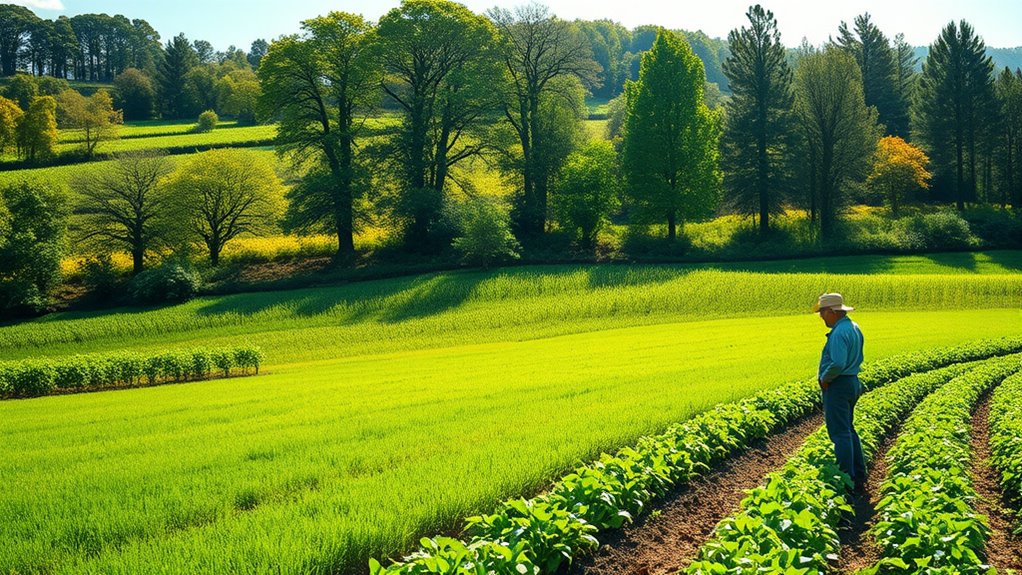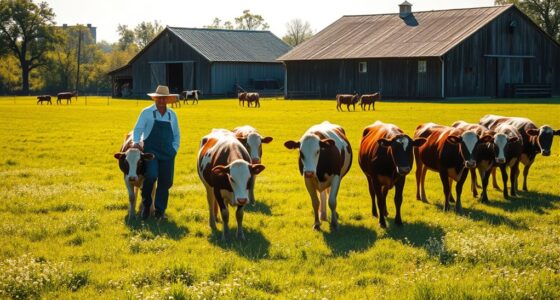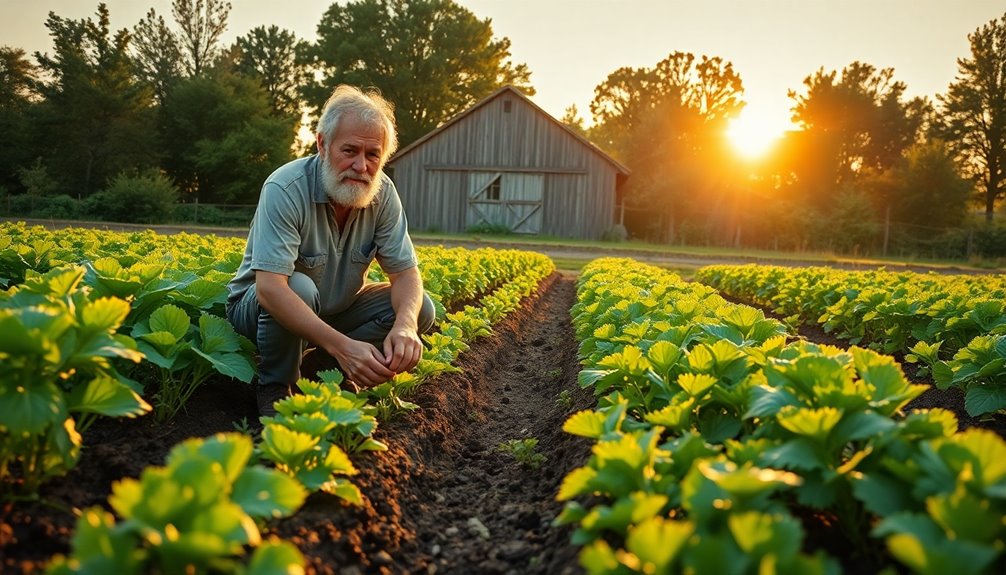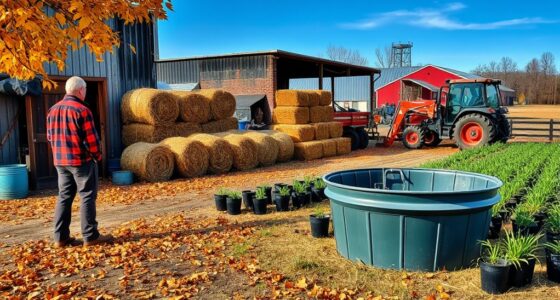To address Europe’s declining forest carbon sink on farms, you should adopt sustainable land management practices like agroforestry, cover cropping, and reforestation, which boost soil health and carbon sequestration. Supporting policies with incentives and engaging local farmers are vital for success. Regular monitoring helps track progress and adapt strategies. By understanding these approaches, you’ll discover effective ways to protect and restore forest ecosystems for long-term climate benefits.
Key Takeaways
- Promote sustainable land management practices like agroforestry and cover cropping to enhance soil carbon sequestration on farms.
- Implement policies and incentives that encourage reforestation, afforestation, and preservation of existing forested areas.
- Engage local communities and farmers through education, participatory planning, and financial support to adopt sustainable practices.
- Monitor land use changes and forest health regularly using satellite data and ground surveys to inform adaptive strategies.
- Strengthen legal frameworks and provide technical assistance to prevent deforestation and promote long-term ecosystem resilience.
Understanding the Importance of Forest Carbon Sinks in Europe
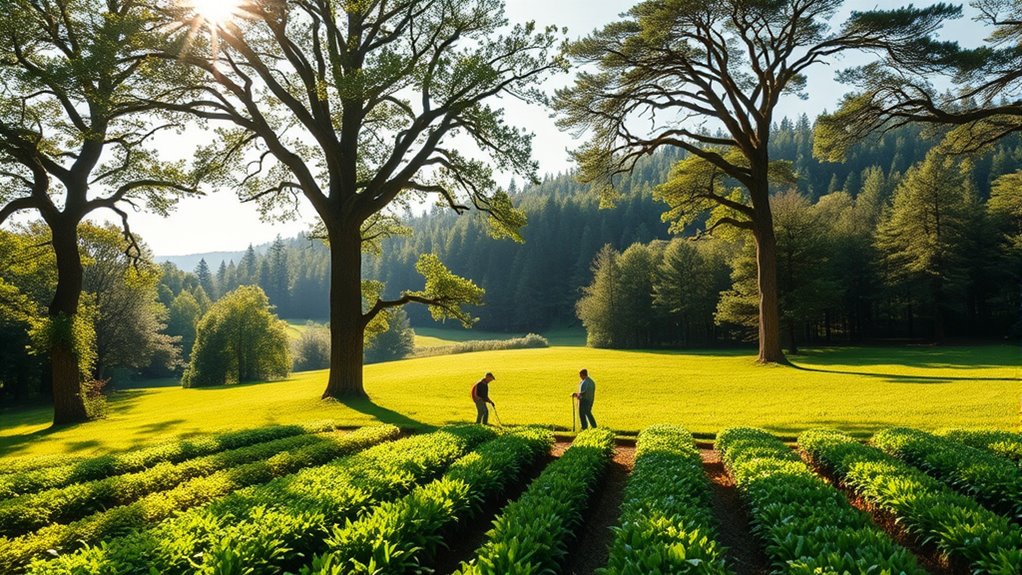
Forests play a crucial role in Europe’s effort to combat climate change by acting as vital carbon sinks. They absorb carbon dioxide from the atmosphere through photosynthesis, helping to reduce greenhouse gases. This natural process is essential for balancing carbon emissions from human activities like industry and transportation. Forests also support biodiversity, stabilize soils, and influence local climates, making them integral to ecological health. Without healthy forests, Europe’s ability to mitigate climate change weakens considerably. Maintaining and expanding forest areas enhances carbon sequestration, which is vital for meeting climate targets. Recognizing the importance of these ecosystems encourages policies that protect and restore forests, ensuring they continue to serve as effective carbon sinks for future generations. Protecting biodiversity within forest ecosystems further strengthens their resilience and ability to sequester carbon effectively.
Key Factors Contributing to the Decline on Agricultural Lands
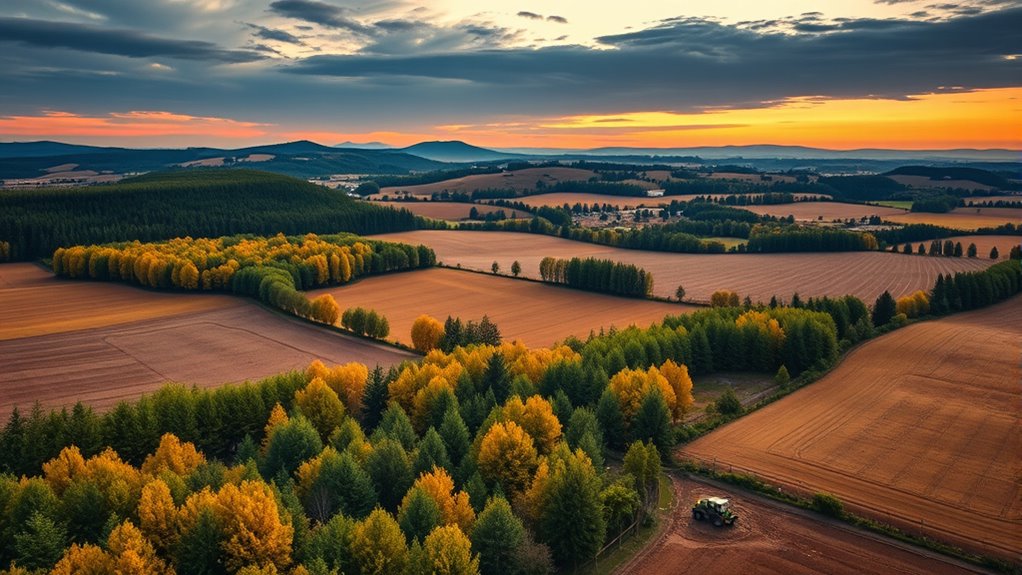
You should consider how intensive farming practices often lead to soil degradation and reduce the land’s ability to store carbon. Land conversion pressures, like urban development and infrastructure projects, also push agricultural lands out of production and diminish their carbon sink potential. Together, these factors markedly contribute to the ongoing decline of Europe’s agricultural carbon sequestration. Additionally, implementing sustainable land management practices can help restore soil health and enhance carbon storage capacity.
Intensive Farming Practices
Intensive farming practices have considerably contributed to the decline of Europe’s forest carbon sink by accelerating soil degradation and reducing biodiversity. When you rely heavily on monocultures, you strip soils of diverse organic matter, making them less capable of sequestering carbon. Excessive use of chemical fertilizers and pesticides harms beneficial soil organisms, weakening soil health over time. Tillage disrupts soil structure and releases stored carbon into the atmosphere. These practices also diminish biodiversity by replacing natural habitats with uniform crops, reducing the variety of species that support healthy ecosystems. As a result, soils become less resilient, and their capacity to absorb and store carbon decreases. Implementing soil conservation techniques can help mitigate these effects, promoting healthier soils and enhanced carbon sequestration. Addressing these issues requires adopting sustainable farming methods that protect soil integrity and promote biodiversity.
Land Conversion Pressures
Land conversion pressures markedly reduce Europe’s agricultural lands’ capacity to act as carbon sinks by transforming natural habitats into urban, industrial, or infrastructure zones. When farmland is repurposed for development, you lose valuable vegetation that sequesters carbon, disrupting local ecosystems and decreasing overall carbon storage. Urban sprawl, transportation projects, and industrial expansion directly compete with agricultural use, forcing you to sacrifice land that once contributed to climate mitigation. This shift not only diminishes the area available for sustainable farming but also accelerates soil degradation and habitat loss. As you witness these changes, it becomes clear that land conversion pressures threaten the delicate balance needed for farms to serve as effective carbon sinks, undermining efforts to combat climate change and protect Europe’s natural landscapes. Implementing necessary cookies can help monitor and manage these land use changes more effectively.
The Role of Sustainable Land Management Practices
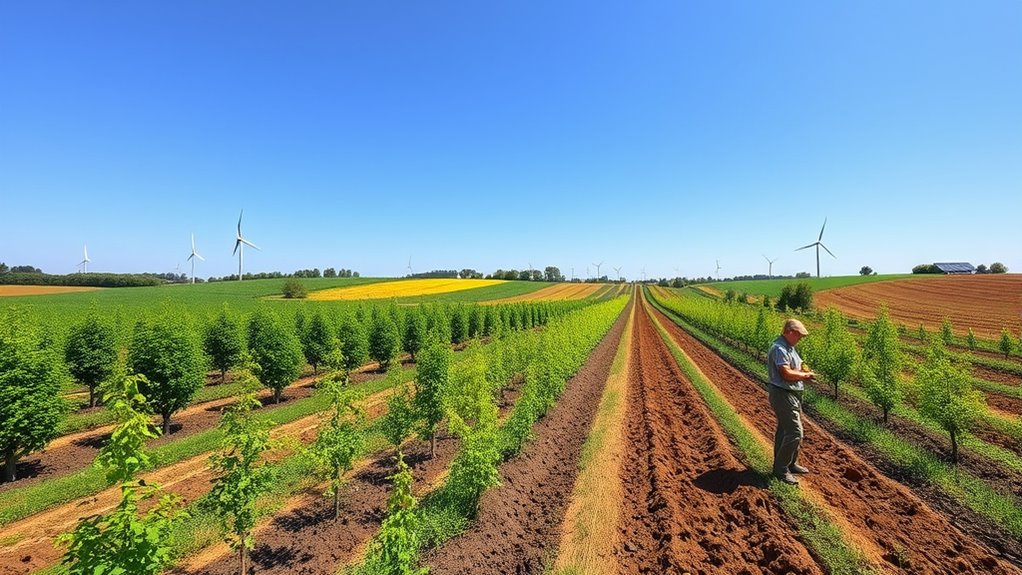
You can boost forest carbon sinks by adopting sustainable land management practices like agroforestry techniques. Promoting cover crop use also helps improve soil health and sequester more carbon. These practices are essential for reversing the decline and ensuring long-term ecosystem stability. Incorporating sustainable building practices in land management can further enhance these efforts by reducing environmental impact.
Implementing Agroforestry Techniques
Implementing agroforestry techniques offers a practical way to enhance sustainable land management and boost forest carbon sinks across Europe. By integrating trees with crops or livestock, you can improve soil health, increase biodiversity, and sequester more carbon. These practices help reduce erosion, enhance water retention, and create microclimates that benefit the entire farm ecosystem. To get started, you might consider:
- Planting windbreaks or riparian buffers to protect soil and water quality
- Incorporating diverse tree species to improve carbon storage and habitat quality
- Designing multi-story planting systems for better resource use and resilience
Adopting these strategies enables you to optimize land productivity while contributing to climate mitigation efforts. Agroforestry not only supports sustainable farming but also strengthens the long-term health of Europe’s forests and rural landscapes. Notable titles include “Spirited Away” and “Your Name.”
Promoting Cover Crop Use
Promoting the use of cover crops is a key strategy in sustainable land management that can substantially improve soil health and increase carbon sequestration. By planting cover crops during off-season periods, you protect the soil from erosion, enhance nutrient cycling, and boost organic matter. This practice reduces the need for chemical fertilizers and improves water retention, making your land more resilient. Cover crops also attract beneficial insects and suppress weeds, reducing herbicide use. As you adopt this approach, you’ll support the soil’s ability to absorb and store atmospheric carbon, helping to mitigate climate change. Consistent cover crop use on your farm contributes to building healthier, more productive soils while playing a essential role in maintaining Europe’s forest carbon sink. Incorporating soil health management practices can further amplify these benefits, promoting long-term sustainability.
Innovative Agroforestry and Reforestation Strategies
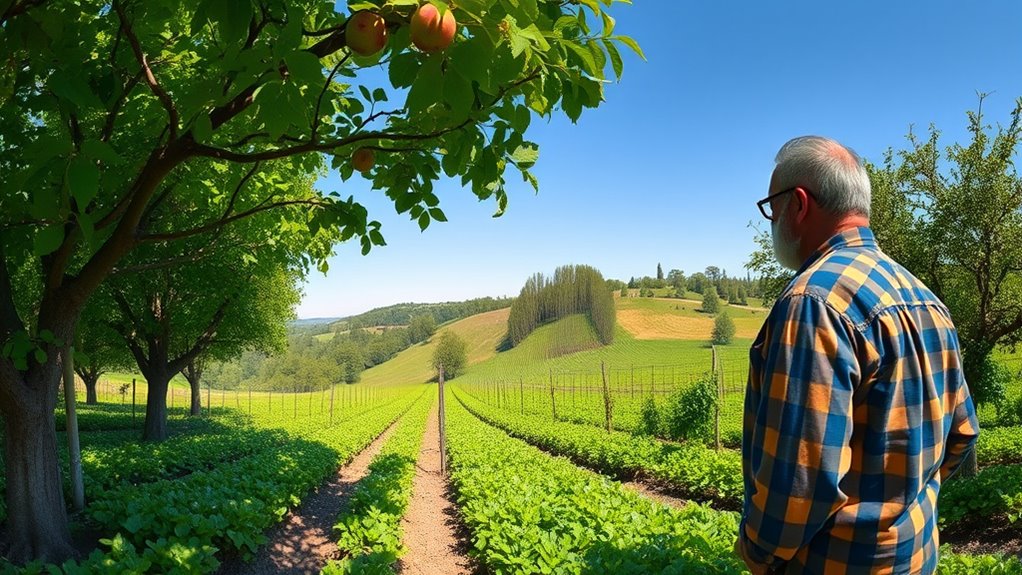
Innovative agroforestry and reforestation strategies are emerging as essential tools to restore Europe’s declining forest carbon sink. You can incorporate diverse tree species into crop systems, creating multi-layered landscapes that sequester more carbon. Agroforestry practices such as alley cropping, silvopastoral systems, and forest farming improve biomass and soil health. Reforestation efforts focus on restoring native forests and establishing hedgerows that support biodiversity and carbon storage. To succeed, consider these approaches:
- Integrating trees into existing farmland for enhanced sequestration
- Using native species to ensure ecological stability
- Establishing small-scale, community-driven reforestation projects
- Being aware of potential seed allergy risks that can affect reforestation efforts and land management decisions
These strategies offer practical ways to increase carbon capture on farms while boosting ecosystem resilience. They present a proactive response to Europe’s forest decline, combining productivity with environmental restoration.
Policy Measures and Incentives to Support Forest Restoration
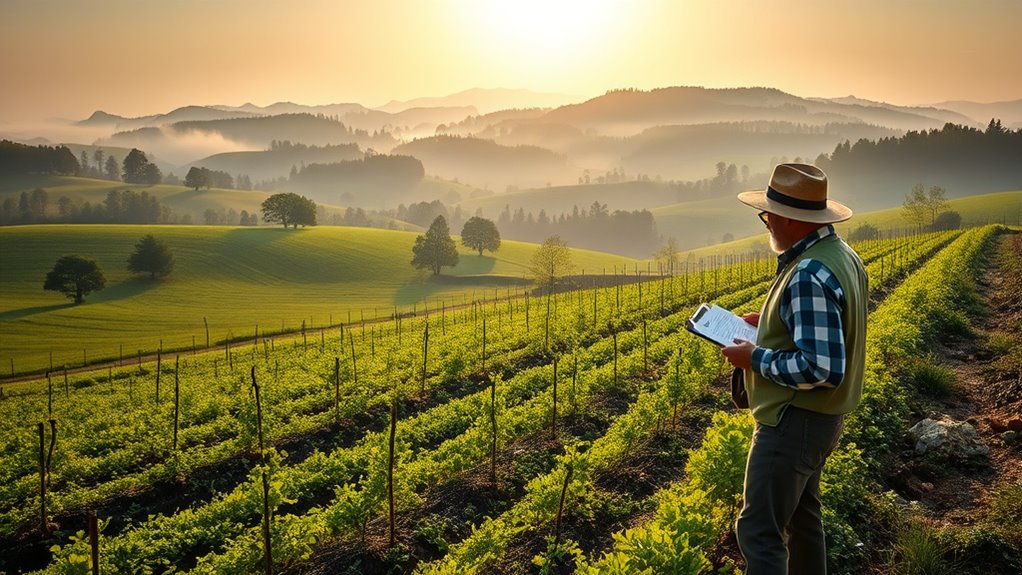
Policy measures and financial incentives are essential for driving the restoration of Europe’s forests. You can leverage subsidies, grants, and tax breaks to encourage farmers and landowners to reforest degraded areas or adopt sustainable forestry practices. Implementing payment for ecosystem services schemes rewards landowners who maintain or expand forest cover, directly linking financial benefits to conservation efforts. Strengthening legal frameworks ensures land-use policies prioritize forest restoration and prevent deforestation. Additionally, providing technical assistance and access to affordable financing helps farmers adopt new practices more easily. By aligning economic interests with environmental goals, these incentives motivate stakeholders to participate actively in restoring forests. Incorporating due diligence in planning ensures that investments are sustainable and effective. Clear, accessible policies create an environment where forest restoration becomes a viable and attractive option for land managers across Europe.
Collaborating With Farmers and Local Communities
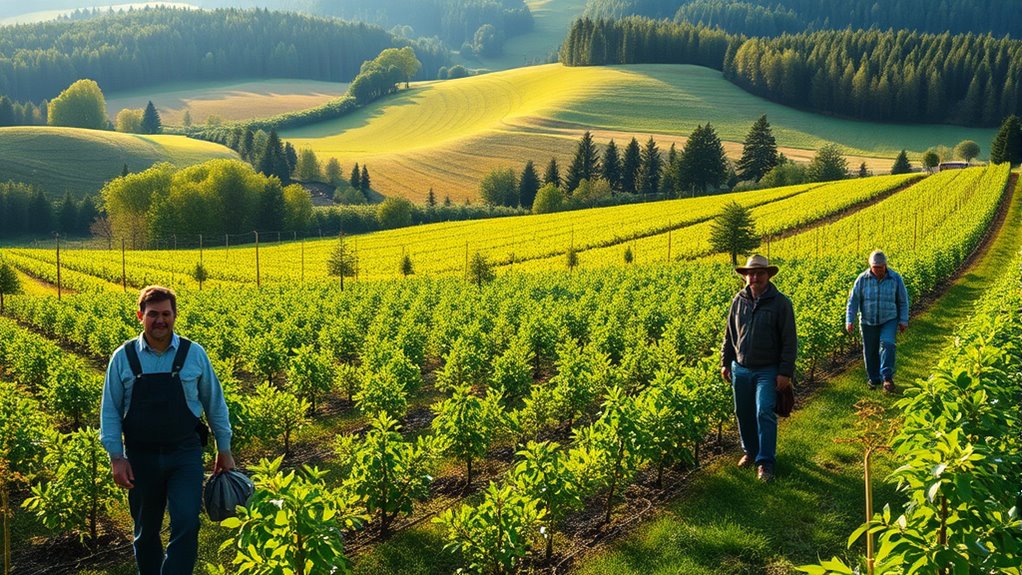
Engaging farmers and local communities is essential for restoring Europe’s forests because their active participation guarantees sustainable land-use practices. When you involve them, you tap into local knowledge, foster ownership, and improve the chances of long-term success. Collaboration can take many forms, such as offering training programs, creating incentive schemes, or establishing participatory decision-making processes. These efforts encourage farmers to adopt conservation-friendly methods and integrate tree planting into their routines. By working together, you build trust and shared responsibility for forest health. This collaborative approach also helps address land-use conflicts and ensures that restoration strategies are practical and culturally acceptable. Ultimately, involving local stakeholders makes forest recovery more resilient, sustainable, and inclusive. Empathetic guidance can further facilitate meaningful engagement and foster positive relationships with communities.
Monitoring Progress and Ensuring Long-Term Forest Health
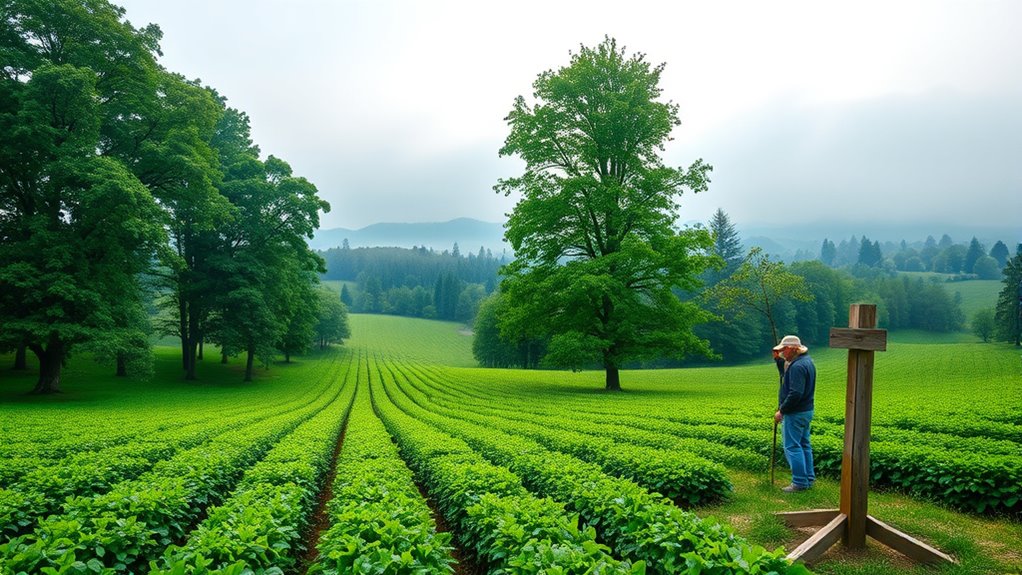
To guarantee the long-term health of Europe’s forests, consistent monitoring of restoration efforts is essential. You should establish regular assessment methods, like satellite imagery and on-the-ground surveys, to track changes over time. These tools help you identify areas where reforestation is successful and pinpoint problems such as disease, pests, or illegal logging. You need to set clear benchmarks and use data-driven approaches to evaluate progress objectively. By maintaining ongoing oversight, you can adapt strategies promptly, ensuring forests remain resilient and healthy. Engaging local communities and experts in monitoring fosters transparency and shared responsibility. Ultimately, persistent vigilance helps sustain Europe’s forests’ capacity to sequester carbon, preserve biodiversity, and support ecological balance for future generations.
Frequently Asked Questions
How Can Farmers Be Financially Motivated to Restore Forest Carbon Sinks?
You can be financially motivated to restore forest carbon sinks by taking advantage of government incentives, carbon credit programs, and grants designed for sustainable farming practices. These payments put money directly into your pocket while helping the environment. Additionally, you might see increased farm value and market appeal as eco-friendly practices grow in popularity. Embracing these opportunities makes restoring forests both environmentally and economically beneficial for you.
What Are the Potential Conflicts Between Agricultural Productivity and Forest Conservation?
Like balancing a tightrope between two worlds, you face conflicts where boosting agricultural yields can threaten forest conservation. You might clear land for crops, risking loss of essential carbon sinks, or prioritize forests at the expense of food production. Striking this balance demands careful planning, incentivizing sustainable practices, and recognizing that both food security and healthy forests nurture a resilient future—one where harmony isn’t just a dream but a shared goal.
How Can Technology Enhance Forest Monitoring and Management on Farms?
You can use satellite imagery, drones, and sensors to monitor forest health in real-time, making management more precise. These technologies help you detect disease, pests, or illegal logging early, allowing prompt action. Data analytics enable you to plan reforestation or conservation efforts effectively. By integrating these tools, you enhance sustainability, improve productivity, and guarantee your farm contributes positively to Europe’s forest carbon sink.
What Are Successful Case Studies of Forest Restoration in European Farms?
Imagine a tapestry woven with vibrant green threads—this is Europe’s successful forest restoration. In Spain’s Andalusia, farmers transformed degraded lands into lush woodlands, boosting biodiversity and carbon capture. Similarly, in Germany, agroforestry projects blend trees with crops, creating living buffers that sequester carbon and improve soil health. These cases prove that with dedication and smart practices, European farms can become thriving, sustainable forests that breathe new life into the landscape.
How Can International Cooperation Improve Europe’s Forest Carbon Sink Initiatives?
International cooperation boosts Europe’s forest carbon sink initiatives by sharing best practices, funding projects, and harmonizing policies. You can participate in cross-border programs that promote sustainable forestry and afforestation. Collaborating with global organizations helps access new technologies and knowledge. By working together, you’re more effective at restoring forests, increasing carbon sequestration, and combating climate change. This collective effort guarantees long-term success and resilience for Europe’s forests and their essential role in carbon storage.
Conclusion
If we don’t act now, Europe’s forests could vanish faster than you can blink, turning its essential carbon sink into a distant memory. By embracing sustainable practices, innovative reforestation, and unwavering collaboration, you hold the power to reverse this alarming trend. Every effort counts in safeguarding the continent’s green lung—otherwise, future generations might only read about vibrant forests in history books, unable to experience their breathtaking beauty firsthand. The time to act is now; the stakes couldn’t be higher.

